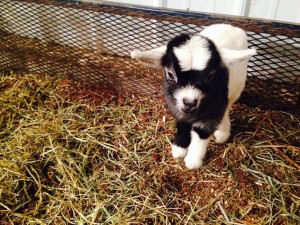Sonam Saxena ’17: The EA community already loves the seeing-eye dogs on campus, so we will love the goats joining us as well? Recent plans have been discussed to bring goats onto campus, in order to unify the three units of the school.
The goat conversation began when a group of students and faculty traveled to Haiti with Chaplin Elect Reverend Tim Gavin. The students discussed their plans for bringing something they learned back to the EA community.
Carolyn Bell ‘16, member of this Jterm, explains, “Upon our return, Father Gavin asked us what we wanted our project to be, and we were excited by the prospect of having a physical connection for everyone at Episcopal to the goat project we had begun in Haiti.”
This goat project in Haiti provided around fifteen goats for breeding, eventually used for meat, milk, insurance, funds and more for the Haitians. In this program, the goats are used as food, but rather as a sort of “insurance policy.” The families primarily rely on crops for food and goats for milk and resources, but if the crops happen to fail then the family will have the goat to sell as a backup.
Maddie Hughes ‘16, also a member of the Haiti Jterm trip, said, “We wanted to come up with a new way to raise money for the Haiti project that would connect all the schools together, because who doesn’t love baby goats? They’ll be a great representation of a piece of Haitian culture for people who haven’t been to the country.”
Gavin, who will ultimately be the primary caretaker of the goats, explains the plans for the two goats coming to campus. He says, “[The goats] would live on campus but we would have to find a fenced-in area for them. The first place they would live would be down by the Lower School pond that is enclosed and will provide enough for them to eat. Eventually they may outgrow and eat out that place, but that’s one of the last things we have to figure out now.”

Photo Courtesy of Carolyn Bell ’16
Bell adds that, “The goats are primarily going to be a staple for Lower School, used to educate them about Haiti to provide a connection and some involvement for our youngest counterparts as a class adopts them each week to keep the connection strong. They will also be utilized by the maintenance crew for bush removal, potentially in AP Biology classes, and we hope that they will be useful in fund raising efforts for the future and current projects at St. Marc’s.”
All students will be able to interact with and learn from the goats, in the hopes of giving our community an even greater sense of unity with our Haitian counterparts. The goats, named “fainting goats,” will be very “docile,” as described by Gavin. He exclaims, “We did not want aggressive goats. You could literally come up behind one of these goats and they would faint if you startle them!” Similarly, the goats will be properly vaccinated and taken care of before arriving at the EA campus and before interacting with any students.
Although this seems like a great program, the funding has not yet been secured. Gavin explained that if Episcopal is responsible for both the cost of the goats initially and food upkeep, these rising costs may prohibit the program. But, its cancellation has not been approved, so hope remains.
Overall, the goal of the goats is to bridge not only a stronger connection between students here but also between Episcopal students and Haitian people, through the expanded knowledge that these goats can provide. Katie Foster ‘17, another member of the Haiti Jterm says, “These new goats will provide a unique way for the Lower School students to interact with the same animals who are helping to support the families of our sister school in Haiti, St Marc’s school. We hope that these efforts will encourage not only education about our counterpart, but also a deeper understanding and connection to them, even at some of the youngest ages of our school community.”
Additionally, Gavin comments, “I think animals in general help a community, obviously like the seeing eye program. I think it brings a certain joy to a community, for example having fish in a fish tank actually brings a sense of peacefulness. I have a turtle in my office and the kids love the turtle. It sort of brings people together. if we have the Lower School kids kind of in charge of the goats and Upper School students and Middle School students are coming to see the goats, it could actually bridge the three units. So I think having animals could bring more unity to the community.”